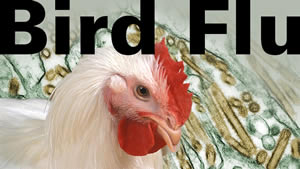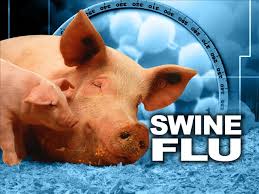Differences between Bird Flu and Swine Flu
Key Difference: Bird Flu is a type of viral infection which is contagious and affects birds. It is caused by the Bird Flu Virus (H5N1 Influenza A virus). On the other hand, Swine Flu is an influenza that affects pigs. It is caused by any of the several types of swine influenza virus.
 Bird flu is also known as the Avian influenza. It is a viral infection that spreads from one bird to the other. The flu viruses are naturally present in the birds. Generally, wild birds contain these viruses in the intestines. These viruses do not create any problem for them. However, swine flu is a very dangerous and contagious infection among birds and it is capable of effecting the domesticated birds like chicken, ducks, etc. Currently, the H5N1 strain of the bird flu has already caused a lot of concern due to its deadly effects. It is capable of spreading very quickly through flocks.
Bird flu is also known as the Avian influenza. It is a viral infection that spreads from one bird to the other. The flu viruses are naturally present in the birds. Generally, wild birds contain these viruses in the intestines. These viruses do not create any problem for them. However, swine flu is a very dangerous and contagious infection among birds and it is capable of effecting the domesticated birds like chicken, ducks, etc. Currently, the H5N1 strain of the bird flu has already caused a lot of concern due to its deadly effects. It is capable of spreading very quickly through flocks.
Generally, bird flu does not affect humans as most of these viruses are harmless to humans. However, in rare cases, humans may get affected with the flu. It can spread to humans, when they come into direct contact with the infected bird. The bird can be dead or alive. The infected bird’s droppings or secretions from their eyes or respiratory tract can be a transmission medium.
 Swine Flu is an influenza that primarily affects pigs. However, the pigs can transmit this virus to people. It is caused by any of the several types of swine influenza viruses. Swine influenza (SIV) or (swine-origin influenza virus) S-OIV refers to any strain of the influenza family of viruses. If the transmission of this virus causes human influenza, then it is known as zoonotic swine flu.
Swine Flu is an influenza that primarily affects pigs. However, the pigs can transmit this virus to people. It is caused by any of the several types of swine influenza viruses. Swine influenza (SIV) or (swine-origin influenza virus) S-OIV refers to any strain of the influenza family of viruses. If the transmission of this virus causes human influenza, then it is known as zoonotic swine flu.
It is generally spread through close contact among pigs and possibly by the passing of a contaminated object from the infected pig to the uninfected pig. It is a contagious disease and can also spread in the human body by coming in contact with a infected person. Coughing and sneezing can lead to the transmission of the disease.
Comparison between Bird Flu and Swine Flu:
|
|
Bird Flu |
Swine Flu |
|
Definition |
Bird flu is also known as avian influenza. It is a viral infection that spreads from one bird to the other. These flu viruses are present naturally in the birds. |
Swine Flu is an influenza that affects pigs. It is caused by any of the several types of swine influenza virus.
|
|
Other names |
Avian influenza |
Pig influenza, swine flu, hog flu and pig flu |
|
Caused by |
Bird Flu Virus (H5N1 Influenza A virus) |
Swine influenza virus |
|
Symptoms |
Swollen heads, a drop in egg production, respiratory distress, diarrhoea, reluctance to move, eat or drink, droopy appearance, inability to walk or stand, unusual head or neck posture lethargy, and sudden death in several birds.
Fever, sore throat, cough, muscle aches, difficult in breathing, pneumonia, pain in abdomen, and diarrhoa. |
Coughing (“barking”), discharge from the nose, sneezing, breathing difficulties, and going off the feed.
Fever (often high), cough, body aches, headaches, fatigue, and runny or stuffy nose. Vomiting and diarrhea may also occur. |
|
Spreading |
Comparatively slow |
Spreads quickly |
|
Casualty Rate |
Comparatively high |
Comparatively low |
|
Transmission medium |
Direct contact with birds, their excretory products, or contamination by infected people. |
Direct contact with pigs, or waste matter contaminated by infected people. |
|
Vulnerable targets |
Small children and rural workers |
Pregnant women, and persons with chronic medical conditions. |
|
Effected system of human |
All systems of human body gets affected |
Respiratory system is affected |
Image Courtesy: bioedonline.org, forbes.com









Add new comment